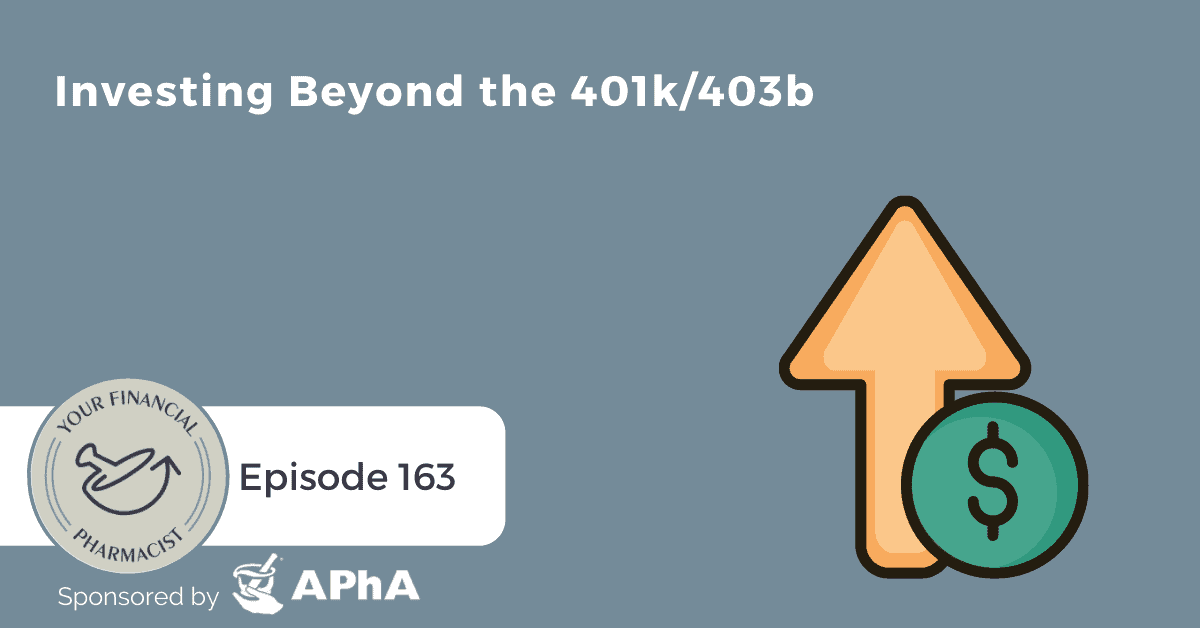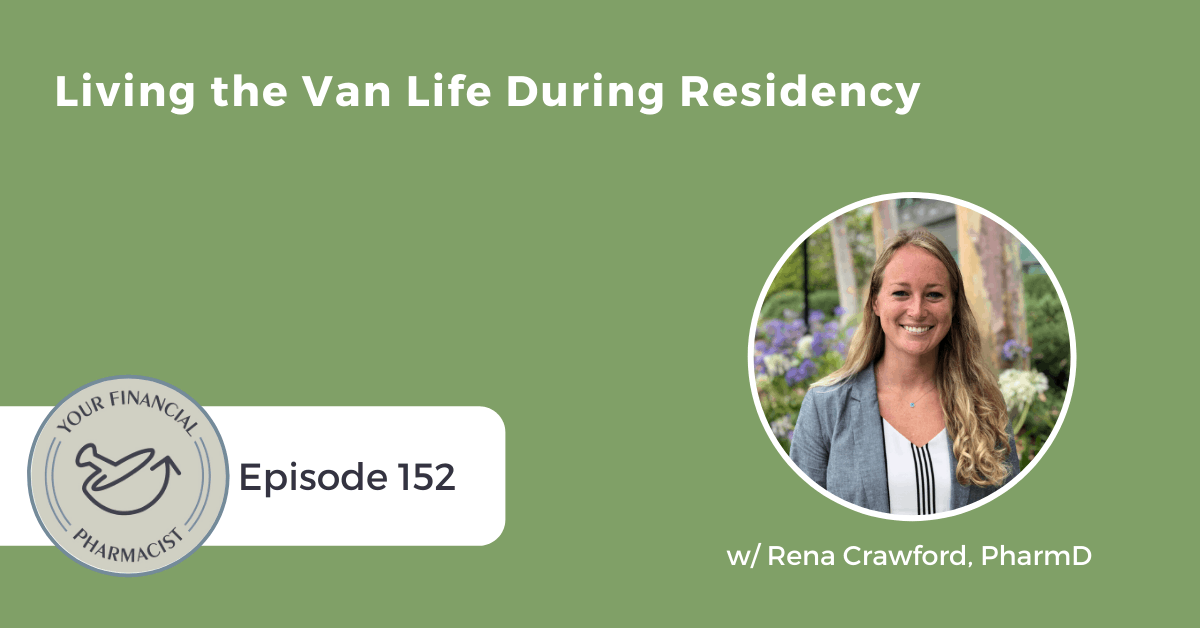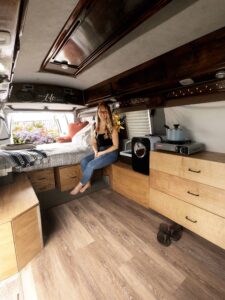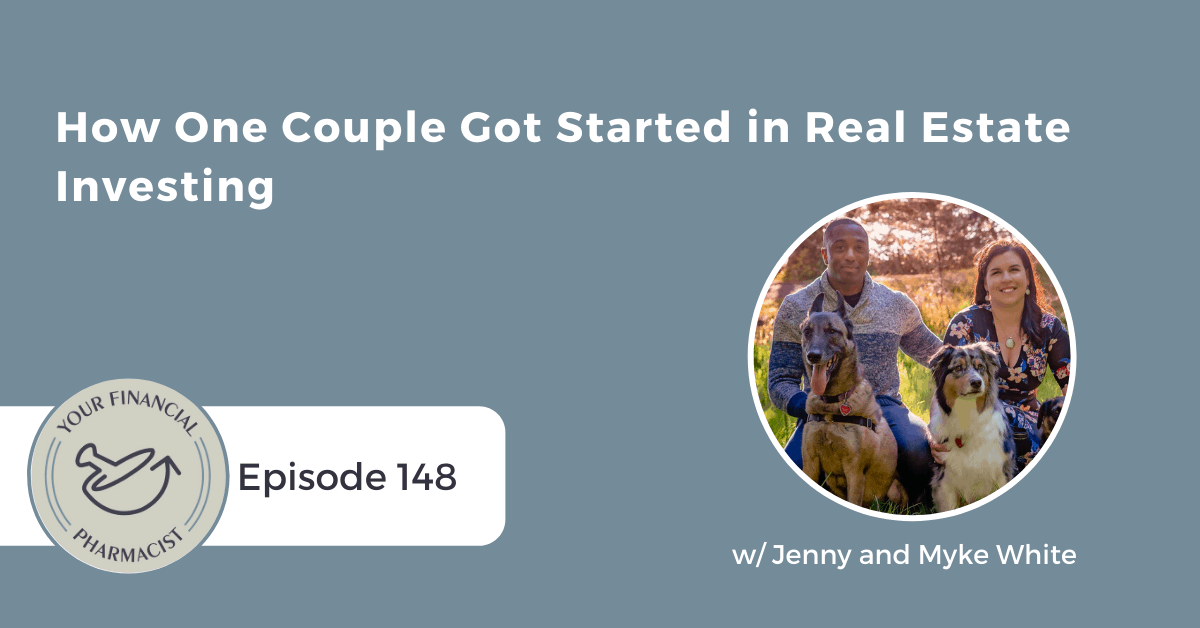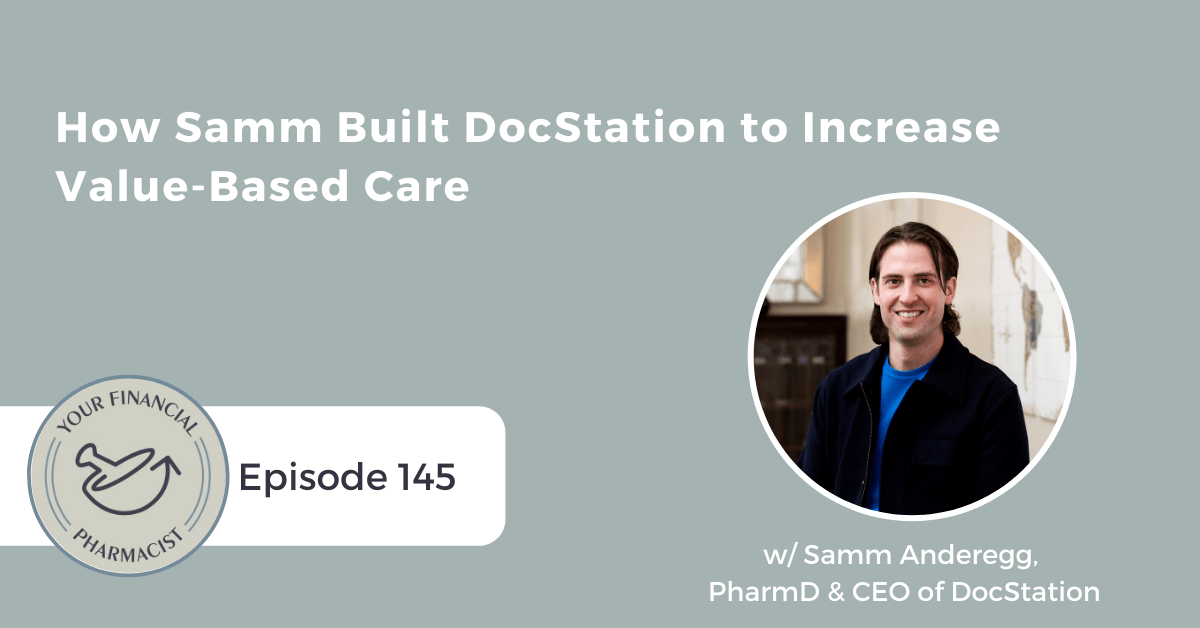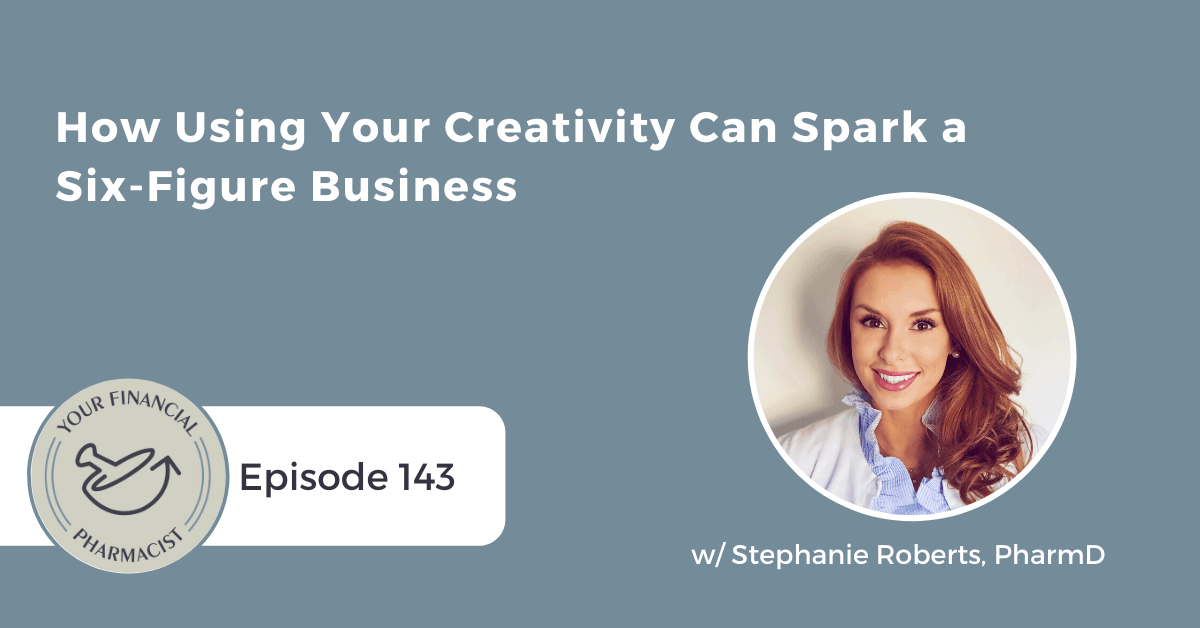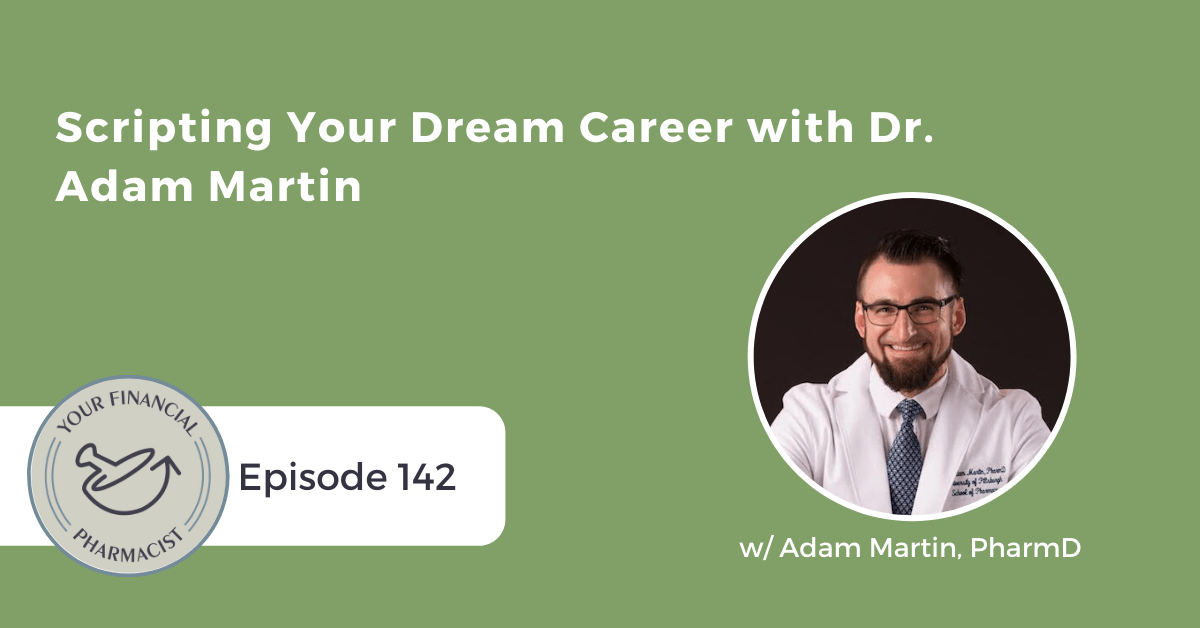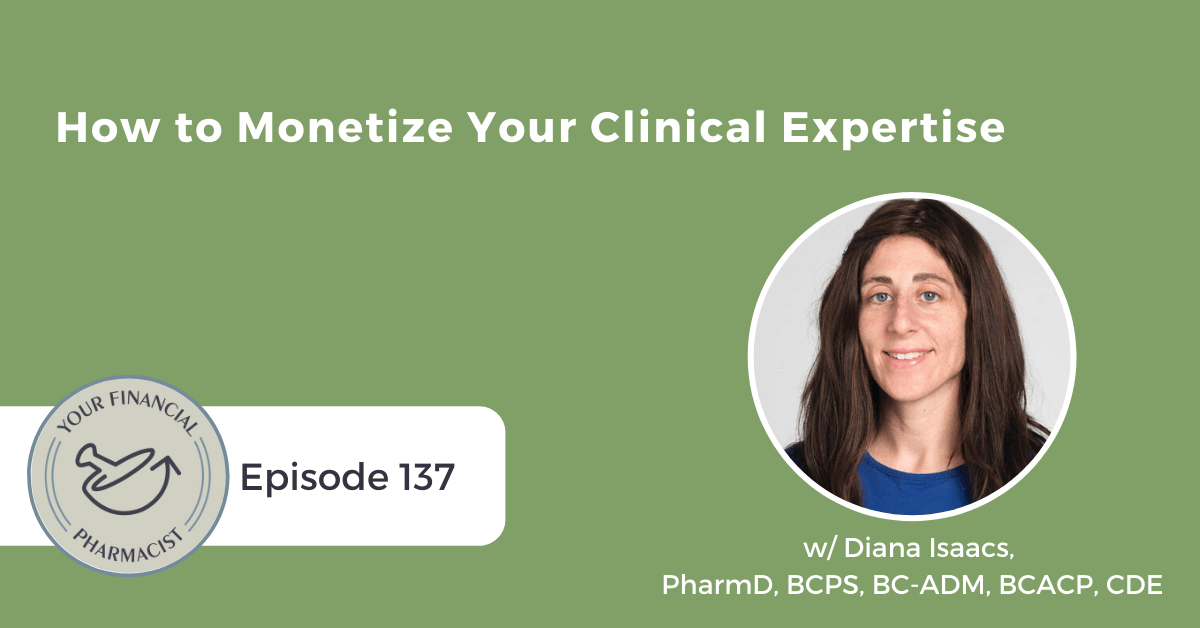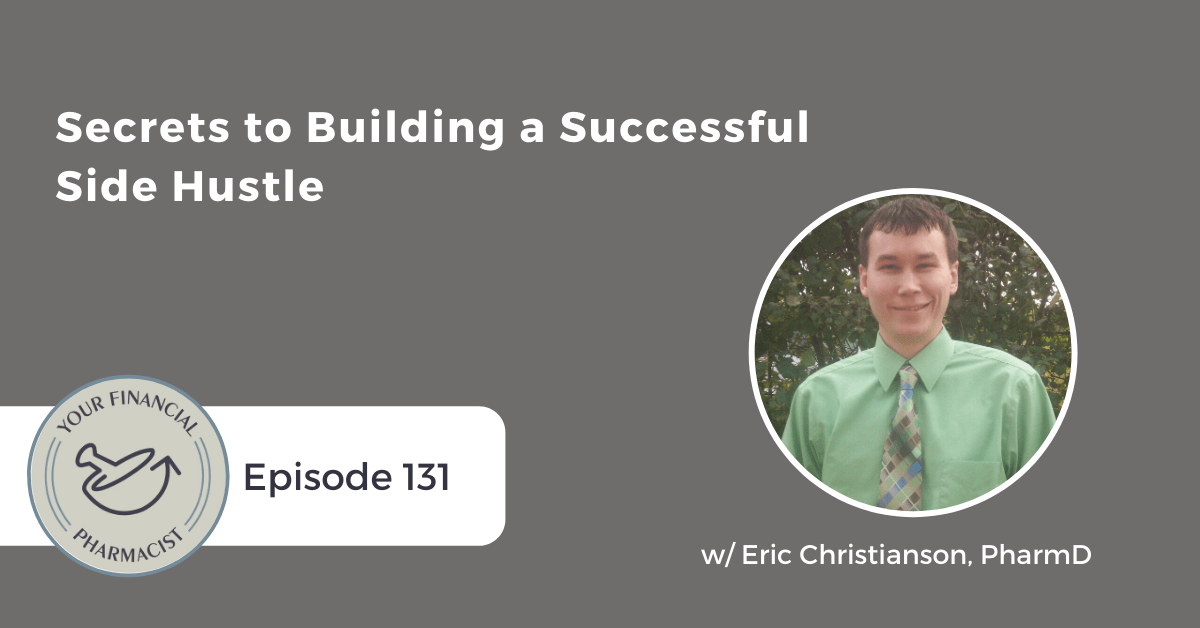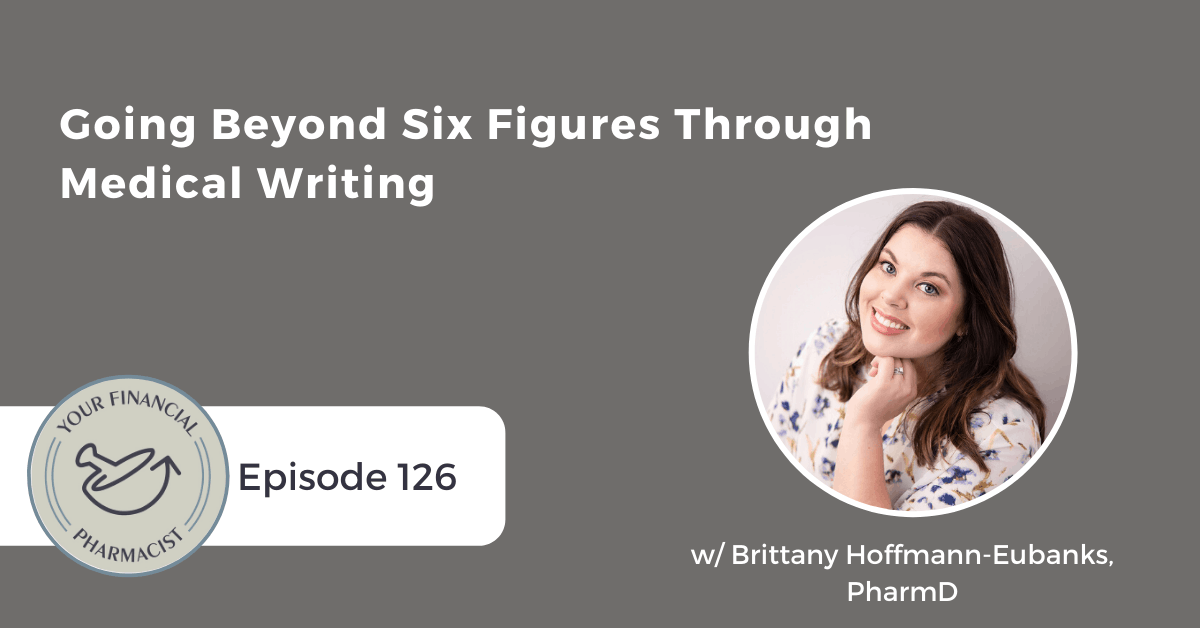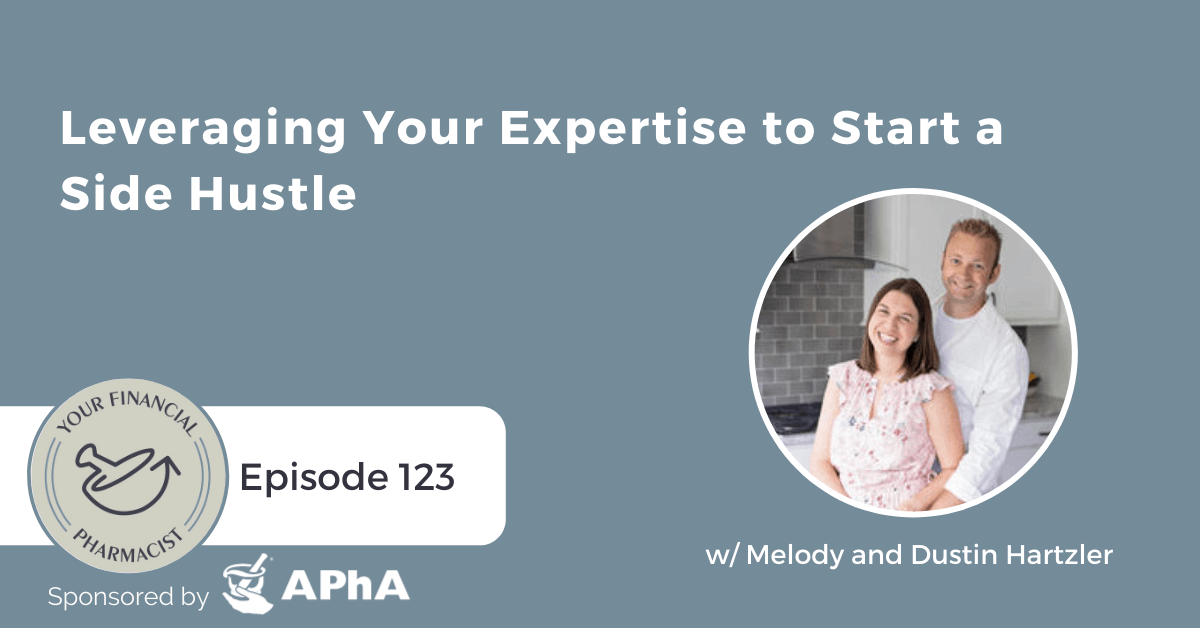Investing Beyond the 401k/403b
Tim Ulbrich and Tim Baker talk about investing beyond the 401k or 403b and break down the traditional IRA, Roth IRA, HSA, SEP IRA and taxable/brokerage accounts by discussing their contribution limits, how to appropriately use them and the advantages and disadvantages of each.
Summary
Tim Baker joins Tim Ulbrich on this week’s episode to break down investment vehicles beyond the 401k and 403b. To start, Tim Baker explains that investing is just one part of the financial plan and should not be looked at in a silo. However, when he works with financial planning clients he helps to get their nest egg on track so that they are financially prepared for their retirement some pharmacists feel overwhelmed that they will need $4 or $5 million at retirement. The certified financial planners at YFP Planning help to provide actionable steps to help you get you on track while keeping the rest of your financial plan in mind.
Tim runs through several investment vehicle options that are outside of the 401k or 403b employer-sponsored plans. He digs into the IRA, Roth IRA, HSA, SEP IRA and taxable/brokerage accounts and discusses their contribution limits, how to appropriately use them and the advantages and disadvantages of each. Tim also talks through YFP’s view of the priority of investing, common mistakes and assessing risk tolerance and risk capacity.
Mentioned on the Show
- Join APhA- Get 25% Off Your Membership with Code: YFP2020
- YFP Planning
- Seven Figure Pharmacist by Tim Church, PharmD and Tim Ulbrich, PharmD
- YFP 072: Investing Mind Tricks: How Behavioral Bias Affects Our Decisions
- YFP 073: How to Determine the Priority of Investing
- YFP 074: Evaluating Your 401k Plan
- YFP 075: DIY, Robo or Hire a Planner?
- YFP 076: Investing Rapid Fire Q&A
- YFP 096: How to do a Backdoor Roth IRA
- Why Most Pharmacists Should Do a Backdoor Roth IRA
- Book a Discovery Call with YFP Planning
- YFP Facebook Group
Episode Transcript
Tim Ulbrich: Tim Baker, welcome back to the show. Two weeks in a row!
Tim Baker: Yeah, crazy. Good to be back.
Tim Ulbrich: Fresh off vacation, right? You’re primed and ready to go, talk about investing?
Tim Baker: Yeah. We spent a week at the Jersey shore, kind of close to my old stomping grounds. And good family vacation away from Baltimore and the city and do some good social distancing on the beach. And yeah, just feeling happy to be back but glad I got to get some quality time with the fam.
Tim Ulbrich: Awesome. So we’re back at it here today, talking about how to invest your money beyond an employer-sponsored plan like a 401k or a 403b, which we’ve talked about many times before on the podcast. And before we jump into this discussion, Tim, I think it’s important that we highlight, as I know I hear you say often, that investing, albeit a very important part of the financial plan, it is just one part of the financial plan. So talk to us about why that is so important that look at it that way. And really, what are all of the different parts that you work with in terms of the financial plan with clients?
Tim Baker: Yeah, so I think one of the issues that I have in, you know, with other financial planners, financial advisors, is a lot of financial advisors will say, “Hey, I do financial planning and investment management.” And it kind of, it grinds my gears a little bit because I think those are like one and the same. Like the investment management is nested in financial planning in the majority of cases. But the reason it’s separated out I think is because a lot of advisors will say, “I do financial planning,” but it’s really just managing your investments. They’ll say, “Hey, Tim, you have half a million dollars, we’ll manage that for a fee or we’ll get commissions or things like that. And then maybe we’ll talk about some of these other things along the way like insurance, especially if I can sell you insurance or hey, the kids are going to college. You’re probably not going to get any help with your student loans or anything like that. So to me, you kind of follow the money. So with the way that most advisors are paid, it’s based on the investments and then if they can sell you kind of a crappy insurance product. So it has like this elevated designation of, you know, with regard to the financial plan. And it is important and it is a main driver. But I think, you know, getting your student loans right, having a savings plan, a plan for the debt, a plan to pay off your house, you’re properly protected from an insurance perspective so you’re managing your risk, estate plan, your taxes, which permeate everything, you’re doing some planning for that. Like to me, it’s just one piece of the puzzle. And I think we kind of put the investment up on a pedestal. And again, it’s important. It’s typically the thing that’s most confusing or most exciting to the average consumer because it’s kind of like this, oh, OK, I can buy shares of this and I can be investing in these companies. But I often argue that those are some times where the more exciting an investment is, typically the worse it is for the investor because they’re chasing returns or they’re tweaking too much. So you know, at YFP, we do all of the things and we fit the investment and retirement piece into that puzzle. But then we also kind of go beyond where we talk about things like credit, credit score, credit report, and you know, kind of the life events of hey, Tim, I’m buying a house, I’m buying a car. I’m getting married, so now I’m combining finances, we’re having a baby, we’re retiring in a couple years, we’re getting into real estate investing, we’re negotiating our salary, we’re downsizing. Whatever that is, to me, those are the main — kind of some of the main drivers. We have the structure that is the financial plan, but then we have these life events that happen that can throw a wrench and kind of force us to zig and zag. So again, the investment is super important, but at the end of the day, it’s going to be one piece of the overall financial journey.
Tim Ulbrich: Yeah, and we’re going to keep coming back to this over and over again, that the financial plan and how you think through your financial decisions should be comprehensive, comprehensive, comprehensive. And so I think especially because we do so many episodes or blog posts or whatever that are more topical in nature. So here, we’re talking about investing. It might be student loans, it might be home buying. And I think it’s just human behavior that you hear something and you’re like, ooh, I can optimize that. Maybe after today, somebody’s like, ooh, I should go max out my Roth IRA. But you know, you take a step back and that may or may not be the best decision once you have a chance to look at all of the different components of the financial plan and understand how one decision can have a ripple effect into the others. So let’s jump in. I want to start by talking about the end, and that really is the nest egg. As we talk about long-term savings, trying to determine what we ultimately need to have saved so that we can turn that into a meaningful plan of what we should be doing today. So as you work with clients, Tim, on this long-term savings strategy, talk us through why that nest egg calculation is so important, what it is, and then how you ultimately are able to back that into a plan of something that they can take action on today.
Tim Baker: Yeah, so you know, typically when I talk to some of our clients that are in maybe 20s, 30s or even 40s, you know, I’ll ask the question, I’m like, “Well, how are you feeling about your retirement?” And you know, sometimes the question is — sometimes, especially early on in the 20s and maybe even 30s, it’s kind of similar to the question that we would ask when we would ask students and residents, probably students at like the APhA conference, we would say like, “How are you feeling about your student loans?” And a lot of the answer was like, “Ah, I just don’t even really look at it. I’m not really worried about it. I’ll figure it out later.” And that kind of perpetuates into like the next, really one of the next big things is trying to establish retirements savings. So it’s like, ah, I don’t really know. So then if I ask the follow-up question — if I say something, if I get an answer like, “Well, I guess I feel good about it, I’m getting a match and maybe I’m putting a little money into like an IRA or something,” I’m like, “Well, do you feel like you’re on track?” And you know, I think that question then kind of goes into like, well, I don’t know. I’m not really sure. I think I want to retire at 65, but there’s some people that think they have to retire or that they’re going to work forever. So what the nest egg is is it’s an exercise that we do, it’s a calculation that we do, and I kind of walk it line-by-line through with the client that says, that shows them if they’re — basically, are they on track or off track? And it’s kind of a binary thing. So what I often say to a lot of clients is like I say, “Hey, you know, you probably need $4 or $5 million to retire.
Tim Ulbrich: What?
Tim Baker: And they typically — yeah — and then they typically look at me like I have 4 or 5 million heads, right?
Tim Ulbrich: Yeah.
Tim Baker: So I say, “Alright, once” — I’m processing that look — once we get beyond that and what we typically do is then is we start to break or deconstruct that number down to a monthly number that we can digest today. So big, big number, way in the future, Tim, that doesn’t mean anything to me. That’s just this noise. That doesn’t connect. That doesn’t connect with me today. So what we do is we then break it down to a number that they can sink their teeth in today. So I can say, “OK, if you need — if we had nothing saved for retirement and you’re getting the match and maybe you’re maxing out your Roth IRA, you’re still running a deficit of $100 per month. So we need to maybe put a little bit money into the 401k or something like that.” So what it does is it provides actionable steps, you know, for them to kind of get on track. And then as they kind of pursue, we kind of check in with that calculation as the years go by, and then as we get into the 40s and 50s and 60s and 70s, we do a little bit more robust planning and kind of decisions that are stuff like, OK, if we retire early or if we downsize our house or if we relocate to this state that’s maybe more tax-free, we can kind of show the effects of that and if your money’s going to run out or not and at what age. So longer story longer, the nest egg calculation is really meant to say, alright, we need some type of money in the future so you’re 30-, 20-, 20-, 30-, 35-year-older self can retire and really not have to work anymore or have the option not to work. So you know, to bring this full circle, the investment plan and the retirement plan that’s kind of executed per what the nest egg says is really, really, really important.
Tim Ulbrich: Yeah, and you know, we’ve mentioned before on the show that saving for the future, whether it’s traditional retirement or something else, it shouldn’t be I hope, I wish, I dream, maybe. I mean, it’s a set of assumptions based on mathematical calculations. And we may or may not like the outcome of that, but we can then begin to understand the variables that go into that calculation and make adjustments or changes, whether that be investments or changes in expectations or adjustments in changes on how we’re executing our savings plan. And so Tim, we talk a lot about wow, it’s really important to invest, invest, invest and do so at an early age and you’ve got to take advantage of compound interest and let it work its magic. But I think we often brush over, you know, what does that mean? And why is that so tangible? So give us the 20,000-foot view of exactly what is compound interest, why that’s so important, and then perhaps an example of how investing can really help someone grow their nest egg. So somebody who is and is not investing.
Tim Baker: Yeah, so you know, we use this quote by Albert Einstein, and it says, “Compound interest is the eighth wonder of the world. He who understands it, earns it. He who doesn’t, pays it.” So a lot of pharmacists, especially early on in their career, they’re feeling it from the paying it side, right? Oh man, I’ve got $200,000 in debt, I’m paying 6.5-7% in interest, you know, this is terrible. But you know, once we kind of have a plan for the loans — and I’m not saying it needs to be paid off — but once we have an intentional plan for the loans and our consumer debt is in check, we have an emergency fund in place, we can then really start dipping our toe very seriously into the investment waters. So you know, so that’s really the idea is that we want the compound interest is our money, we’re taking risks to earn it. But we’re putting it out, we’re putting it into companies and to maybe bonds and we’re saying, “Alright, here’s some money. Hopefully we can earn dividends and capital appreciation as we go. And I can get a much better return down in, basically in the future.” So to give you kind of a case study — and the reason this is really important is, you know, if we talk about Ally Bank, a big one for a high yield savings vehicle, but as many people with where interest rates are, you’re making like 1%. And one of the main things that you’re combating as you’re building wealth is tax, so Uncle Sam always needs his bite of the apple, and inflation. So — and I think, Tim, you might have created this graph, but I showed the graph of the $10 latte. So you know, if you have a latte that costs $4 in 2020, using historical rates of inflation of about 3%, in 30 years, that latte will cost $10. So this is why my dad, who’s in his 70s, would say, “Well, Tim, back in my day, the nickel would buy the whole candy store.” And now it doesn’t buy anything because prices, the prices of goods and services go up naturally over time.
Tim Ulbrich: So just a quick aside, Tim, on that. It made me laugh when you said that. I just — the other day with my boys I had a box of Cherry Heads with like a $.25 sign on the corner of the box, and I was like, “When I was a kid, we used to go out to the candy store. And those were not $.25.” So.
Tim Baker: Yeah. I mean, my wife sent me a picture of I think she filled up at like $1.25 because she had some points or whatever. And I was kind of reminiscing, like I think it was either when I started driving or when my brother started driving, gas was at like $.89 or $.99 a gallon.
Tim Ulbrich: I remember that.
Tim Baker: You know? And you see it in the movies. And those are — that’s a staple of American life. That’s pretty kind of inflation-focused because people really get upset when gas goes up because it’s right in our face, but if you think about all these other, I mean — gosh, we could talk about college tuition and drive our listeners off a cliff here. But yeah, I mean, prices just go up. So to combat the taxman and the inflation monster, we have to — we can’t just put our money into the mattress and not take risks. We can’t just put our money into a bank account and not take risks because naturally, maybe that $500,000 that you have in your bank account, maybe it’ll some interest, but in 30 years, it’s going to purchase about half of what you can purchase today.
Tim Ulbrich: Right.
Tim Baker: So if we take a case study here, so we’re going to talk about Conservative Jane. So Conservative Jane, she’s a pharmacist, she makes $120,000 in income, she gets her 3% cost of living raises, which might be generous. She gets that every year. She’s going to put 10% into her retirement plan, but she’s just going to put it into a Money Market, which is like a cash-like investment. And she’s going to work for 30 years. Over the course of that 30 years, she’s going to accumulate a nest egg of about $600,000. So you’re going to say, hey, that’s not too bad. But because hopefully a lot of our listeners are reading “Seven Figure Pharmacist,” we assert that — or at least you and Tim Church assert and I agree — that we need to be thinking like millionaires because it’s going to — that is what it will take for us to achieve that financial freedom, that financial independence that we’re looking for. So this Conservative Jane, she’s really afraid about what the market has done in the ‘08-’09 crisis, the subprime mortgage crisis if you remember that, the COVID crisis where the stock market did a nose dive here and now is recovering. And she’s saying, “You know what? I don’t want to look at my balance and see it go down. I just want to slow and steady.” So unfortunately, that amount of money is not really — if she retires at 65, it’s not going to last her until 95, 100, 105, which is typically what she’ll live to. So in an alternate reality, which again, another of maybe Einstein’s theories, we wave our wand and we say, OK, if we take a more aggressive stance with our investments and we take the exact same Conservative Jane with the same income, $120,000, the same cost of living raises, the same contribution amount, 10%, and the same timeline of career, 30-year, and the only thing that we do differently, the only variable that we change is we change the stance towards investment. So instead of being conservative, we’re being aggressive. And what the market bears consistently over 20+-year periods, it’s about a 10% return. And when we adjust that down for inflation, it’s about a 6.87% return. So this is where Aggressive Jane is now taking advantage of that compound interest, so those capital appreciation where you buy that stock at $100 and it sells for $500 in the future. Or the dividends that these companies will reward shareholders over time for being investors. So when we do that and we get that 7% return, it’s about a $1.2 million swing. So that nest egg is not going to be $600,000 now. With Aggressive Jane, it’s going to be $1.8 million. So and you’re not doing anything different except for your stance. So it’s going to be a rockier road, it’s going to be a bumpier road because you’re going to have ups and downs in the market, but if you believe that the market takes care of you over time like we do, it’s going to be OK. So to me, that is the power. And when we show that and we can demonstrate that in the nest egg calculation to say, hey, we’ll talk about risk here in a little bit. This is your risk tolerance, you’re showing this type of portfolio, but if we’re a little bit more aggressive, then they’re like, oh, well I don’t have to save as much right now or I’m actually set for where I’m at. I don’t have to work until I’m 85 years old. And I think demonstrating that, you kind of get that (sigh). And we’ve had clients that have looked at this and were like, alright, well, one spouse was maybe I don’t need to work anymore. We could have a single-income family because we want to stay home and raise the kids. That’s the power in it is to have some intentionality about what we’re doing and we’re not just like oh, I don’t really know how I’m tracking for retirement. And the sooner that you do it, you know, one of the big things that we say with working with a lot of young professionals is time is a great asset to have. We do believe that the income that pharmacists make is great. But time is a great asset to have, and it can kind of be a double-edged sword because some people are like, well, I have 20-30 years to figure that out. But the sooner that you figure it out, the better.
Tim Ulbrich: And I just love that example because as you had mentioned, one variable that was different, you know, where you put that money — so instead of a Money Market account, you’re investing that. We’ll talk about vehicles to do that here in a moment — the only variable that’s different. So you’ve already done the hard work. You’ve already said, “I’m going to save x% of my salary.” That example was 10%, perhaps those that are listening are aspiring for a higher number. But you’ve already made that hard decision. Now it’s a matter of where do I put that to be able to put myself in the best advantage and best position to achieve my long-term goals. So we’ve talked about the concept of what you need in the nest egg. We’ve talked about why investing and compound interest is so important. So the next natural question is, well, how do you get there? Where do I put my money? What are the options that I have available? And this episode is all about investing beyond the 401k and 403b. So we’re not going to talk about those two, and we’ll link to our investing series back from episodes 072-076 where we have more information on those. So let’s jump into those other investment vehicles beyond the 401k or 403b, Tim. And here we’re going to be talking about traditional IRAs, Roth IRAs, HSAs, SEP IRAs and taxable brokerage accounts. So we’re going to do this in a rapid-fire format. So Tim, we’ll tee up each one one-by-one, we’ll start with the IRA. And I’d love for you to talk about, you know, generally, characteristics and design, contribution limits and perhaps some advantages and disadvantages with each of these options. So let’s start off with the IRA.
Tim Baker: Yeah, so the traditional IRA or just sometimes called an IRA, this is an investment vehicle, I like to say investment bucket, that you can use as an investor often to supplement your 401k, 403b. So with this particular bucket, it is a bucket that you fill with pre-tax dollars. So anybody can contribute — anybody that has earned income can contribute to a traditional IRA. Now, once you start making more money than say like a resident makes, if you’re a normally salaried pharmacist, you don’t get that deduction but you can still put non-deductible contributions into your IRA, which you don’t get that tax benefit. And then any money — and this goes for any of these vehicles that we’re talking about — any money that’s inside of that bucket grows tax-free. So if you get investment income or if you get dividends paid, you’re not taxed on that. So outside of that, in the taxable account, you are taxed on that. And I’ll talk about that when we get there. So typically the contributions that you can make into these accounts are $6,000. So that’s in aggregate with the Roth IRA, which we’ll talk about here in a second, next. So if you put $4,000 into a traditional IRA, you can only put $2,000 into a Roth. So it’s in aggregate. But it’s completely separate from your 401k, 403, TSP. So these aren’t tied together in terms of contribution amount. Once you reach age 50 or older, you can put an extra $1,000. And like I said, this is subject to phase out for the deduction. So the IRS will look at your AGI and say, “Hey, Tim, you make too much money. You can put money in here, but you’re not getting that deduction.” So the appropriate use here is that you’re supplementing a 401k or you have no retirement savings, so again, we work with a lot of independent pharmacists that don’t provide a 401k to their employers. So call me if that’s the case, we can definitely help there. But in the meantime, you can use this as really your main retirement. And then in that case, you do get a full deduction, no matter what you make. You want to shelter your income from tax, so if you are trying to lower your AGI and you can, if you’re in the right tax bracket, so you’re a resident, that’s the way to do it, you’re deferring taxes on your investment portfolio. So it’s not taxed going in, but it is going to be taxed coming out when you distribute it in retirement. And then this is for long-term accumulation for retirement. So you’re not going to put money in here and then use it for a home purchase or something like that. So the biggest advantages here is, again, it’s a tax benefit, the investing selection is nice. So you can typically — I always talk about with the 401k, you kind of have to play with the toys in the sandbox, so you only get 20-30 selection. Here, you can basically invest in anything you want.
Tim Ulbrich: Right.
Tim Baker: And typically, less fees associated with it. Now the big drawback is if you do take money out, it’s a 10% penalty unless you’re 59.5. You can take loans against it, which I think is actually a benefit. And then the distributions when you’re retired are taxed as ordinary income, which is not great. So hopefully — I don’t know if that was quick enough, Tim, but those are the high level pieces.
Tim Ulbrich: No, that’s great. So there we were talking about traditional IRA. Let’s talk for a couple moments then about the Roth IRA.
Tim Baker: Yeah, so Roth IRA, a lot of the same things are true. The main difference here is that this is — you’re contributing it to a Roth IRA with after-tax monies, which means that you don’t get a deduction going in, so you pay the tax up front, it grows tax-free, and then when you distribute it in retirement, it comes out tax-free. So one of the things I’ll talk about is like I say, “OK, Tim Ulbrich, you have $1 million in your Roth IRA and $1 million in your traditional IRA. How much money do you have?” Unfortunately, your balance sheet says $2 million, but that’s not what you actually own because in the traditional IRA, Uncle Sam hasn’t taken his bite of the apple. So if you’re in a 25% tax bracket, in the traditional IRA, you own $750,000 of that and the government owns $250,000 of that as it’s distributed. So that’s kind of a high-level look at that. So you can convert a traditional IRA to a Roth IRA, and that’s kind of a separate ball of wax, but you can contribute up to $6,000, there’s a catch-up phase, again, this is typically to supplement the 401k. You’re looking for long-term retirement. You can use this money for like a first-time home purchase, you can distribute up to $10,000 without a 10% penalty. So there are some little nuances to — you don’t have loans or anything like that.
Tim Ulbrich: Yeah.
Tim Baker: And typically the investment selection is good. There’s less fees associated in most cases compared to like a 401k. And your distributions of basis, which is the money that you put in, are always tax- and penalty-free. Now the earnings that it makes could be taxed and could be penalized based on the situation, so that’s something to keep in mind. So high level between traditional pre-tax, not taxed going in, grows tax-free, tax comes out when you distribute it. For a Roth, it’s taxed going in, it grows tax-free, and then it’s not taxed coming out. So I usually take clients through some pretty cool graphics that show them that because it’s harder — oh, and the big thing I forgot to say — this is important — is that for a Roth, for a traditional IRA, anybody can contribute to a traditional IRA, maybe not get the deductions. For a Roth, once you start making a certain amount of money, the door starts to slam shut for you to actually make contributions. So as a single earner in 2020, once you start making more than $124,000, that Roth IRA door starts to shut. So then that’s typically where we do a nondeductible contribution to an IRA and then do a backdoor contribution to a Roth IRA.
Tim Ulbrich: Yeah, and since you mentioned that, Tim, and I’m glad you did, the backdoor, I would point our listeners to Episode 096. We talked about how to do a backdoor Roth IRA. And we also have a blog post on why every pharmacist should consider that as an option with their investing plan. We’ll link to both of those in the show notes. So that’s the IRA and the Roth IRA. Next up is the Health Savings Account, the HSA, also known as the Stealth IRA. Talk to us about that one.
Tim Baker: Yeah. So this is typically paired with a high deductible health plan. So a high deductible health plan is a health plan that you’re — for an individual, the minimum annual deductible is $1,400 a year or more. And the max out-of-pocket expense is $6,900 a year more. So if you have the option with your employer, you’re young, you’re healthy — I guess you can be older and healthy — but if you’re healthy, you don’t go to the doctor a lot, this might be a thing to look at. And you can couple the HSA with this. So this is — the HSA is different from an FSA. FSA is a use-or-lose fund. So every year, you’re going to say, “OK, if I put $1,000 into this and I don’t use it, then I lose it.” And it doesn’t accumulate over time, so at the end of the year, you’re buying a bunch of stuff for like contacts and things like that. I don’t like playing that game. Whereas the HSA, it does accumulate over time. So you don’t have to use it. So the money goes in cash and then for some HSAs, you can invest it dollar one or maybe you have to wait for you to have a balance of $1,000 and then you can invest above $1,000. It just depends on the HSA. But it allows you — it’s very similar to an IRA in a sense of how you invest it. Now, the main thing for this, it has a triple tax benefit. So what I mean by that is for the IRAs, we were talking about a double tax benefit. You either get a tax break going in or going out. And it grows tax-free. With the HSA, there’s a triple tax benefit, meaning that you get a deduction — and it doesn’t matter how much money you make. So you could make $10 million a year, and you’d still get this deduction. You get a deduction as it goes in, it grows tax-free, and then it comes out tax-free if it’s used for qualifying medical expenses or once you reach age 65, you can use it for really whatever you want. So for a lot of people, they use this is as almost like another IRA bucket, which is what my household uses it for to get that. So it never sees the IRS. It never sees the taxman, if you do it correctly. So you can put up to $3,550 as an individual, $7,100 as a family, and then there’s a catchup after age 55, I believe. So you know, the advantages, the advantages of this is obviously the tax treatment, it’s another bucket that if you’re a little bit higher income that you don’t get some of the tax breaks like the traditional IRA deduction, you can put money in there. So what we try to do as a family is we fund this first and then we try to cash flow our health expenses as best we can.
Tim Ulbrich: So that’s the traditional IRA, Roth IRA, HSA. Talk to us about us about the SEP IRA.
Tim Baker: Yeah, so the SEP IRA out there is typically for those self-employed pharmacists out there or maybe ones that are running a side business or could be they work for a small business owner that has a SEP IRA as their sole retirement plan. So they look and act very similar to a traditional IRA, but they’re kind of like a super IRA because the contribution limits are a lot higher. So this is an employer-sponsored IRA, so if you work for a company that has a SEP, you don’t put any money into it at all, and you can’t put any money into it at all. The employer basically has to put — and they’re not necessarily as popular once you start getting employees just because there’s flexibility on when, you know, so you don’t have to contribute to it every year. So if you have a down year because of COVID or whatever, the business owner could say, “Hey, I don’t want to contribute this year.” But next year when business starts to pick up, you have to contribute at the same rate as you contribute to yourself. So if I put 10% in for what I make, you have to do the same for your employees. So typically the rules here, eligible employees have to be at least 21, they have to work for the employer at least three out of the last five years, they have to earn at least $600. So if you’re the employee and the owner, so if you’re one and the same person, this is kind of what I used early on in my business, a SEP, to basically save for retirement above and beyond the traditional IRA. So you can typically put in like the lesser of 25% or up to $57,000 as of 2020. So the hard part about this — and one of the disadvantages — it’s really hard because you’re really looking at what the business profits are to kind of gauge what you can put in. So in my experience, I would put money aside and then like on tax day when I had all those numbers, then that’s when I would kind of check the SEP IRA. So long story short, the IRA is just typically used for those self-employed, if you’re running a side business, you might be able to shelter a little bit of the business income there to help from a tax perspective, from a Schedule C perspective. But there’s no Roth component or anything like that. So there are some disadvantages.
Tim Ulbrich: So we have lots of tax advantage savings vehicles. So obviously the 401k or the 403b, traditional IRA, Roth IRA, HSA, SEP IRA, so as we talk for a moment about taxable brokerage accounts, not only what are they but what would their role be, considering that we have all of these other options available?
Tim Baker: Yeah, so the taxable account — and we can kind of talk about this in kind of the mistakes that I see — but the taxable account is often — think of it as like a savings account but on steroids. So instead of in the savings account that money just sits in cash and maybe earns an interest rate, in a taxable account, you can actually convert that cash into shares of an investment, you know, Facebook stock or S&P 500 ETF or a mutual fund, and then that’s where you start earning the capital appreciation, the dividends, etc. So the contributions here, it’s really unlimited. So you know, you can put a couple bucks a year into it or millions of dollars a year. It’s really — the world’s your oyster. Same thing with the investments: You can basically invest in whatever you want. There’s restrictions like you see in some of the retirement plans. You typically use this when you’ve exhausted your retirement contributions to some of these other accounts that we’ve talked about or if you say, “Hey, Tim, I want to retire at age 55,” a lot of these accounts, the IRA, the 401k, they’re going to say, “Hey, you’re going to be penalized to take money out until you reach this kind of arbitrary age of 59.5 years old. So if I retire at 55, I can’t get that money out of the 401k without a penalty. So when you might use this account for like near — like kind of the beginning phases of retirement and then shift — when you get to age 60, shift over. The other use for this is my wife and I use this for a future car purchase is we see where rates are and how the saver is taking a beating now because interest rates are so low. So we say, alright, we can use this taxable account, we’ll put a car payment worth every month into a taxable account and hopefully over the next five years, the average investment return in the S&P 500 is about 6-7%. Hopefully we can get that versus the 1% that we’re getting in our high-yield savings account. So it’s more of a near- to medium-term goal, which could be a home purchase, a car purchase, maybe real estate investing, investment, with the caveat that you could lose that investment. So you know, there’s risk there that you’re taking. So big advantages in terms of flexibility, there’s no penalty to withdraw, you can recognize losses to offset gains. So this is where you’re paying capital gains, whether they’re short-term or long-term. So when you buy that share at $100 and sell it for $400 in a taxable account, you’re paying $300 in capital gains per share. And so that is one of the disadvantages to the taxable account.
Tim Ulbrich: So Tim, we started by talking about the nest egg, what you need, and then we talked about the importance of investing and taking advantage of compound interest to get there, and then we talked about the vehicles that are available to get there, lots of different ones. So then the next question is, OK, well how do I prioritize this? I’ve got some dollars that I want to save each and every month towards my long-term savings goals to get to that nest egg and take advantage of compound interest. But with all of these options available, where do I go and in what order? And so this takes me back to Episode 073, where we talked about the priority of investing and we talked about the order in which we think you should consider filling your long-term savings or retirement buckets. And it’s important to say, as with any other part of the financial plan, this has to be tailored to the individual. So of course, this is not investment advice. But walk us through again, Tim, at a high level what we think of as the priority of investing between these different vehicles that are available to someone.
Tim Baker: Yeah, so assuming that we have kind of the foundation in place, the consumer debt is kind of taken care of, emergency fund, we don’t owe any taxes, we have a plan for the student loans, we’re kind of accounting for more of the near-term goals like travel, wedding, home purchase, education planning for the kids, really as we kind of wade into the how you prioritize, it’s going to depend. Obviously that’s my statement answer, but in most cases what we would say is you want to start with the employer match. That is — we talk about that’s free money in 99% of cases. 95% of cases, you always want to get, at least get the match so you don’t forego that benefit. And then typically, the next step, the decision tree here is based on if my — how great or not so great my retirement plan is. So you know, in a lot of cases, retirement plans, 401k’s, 403b’s, they have a lot of fees associated that the investor doesn’t necessarily see. So what we typically say is that if you don’t know, it might be good to go out into the IRA/HSA world and max those out next. And then go back into the 401k, the 403b, the TSP and get the max, which is in 2020 $19,500. And then from there, from a traditional investment perspective, that’s when you would start loading up in the taxable account or if you’re more nontraditional, you might look at real estate investment, investing in businesses, or something like that. So that’s typically kind of steps 1, 2, 3 and then 4 with regard to how to kind of prioritize your approach to filling your retirement buckets.
Tim Ulbrich: And you talked about one of these already, but common mistakes that you see people make in the investment prioritization, but talk us through some others that you commonly see as well as people are trying to sort out these different options.
Tim Baker: Yeah, so you know, often when I come across — and I had a conversation with a pharmacist here recently. You know, they get into investing before the debt is paid or there’s a plan for the debt. So that could be a student loan, that could be a credit card or a personal loan. So you know, you have $10,000 in credit card debt, but you’re putting 10% in — you get a 5% and you get a 10%, and you have a 10% contribution into your — you know, that doesn’t really make any sense. Or sometimes there’s no purpose or goal with the investment. So most of these accounts that we’ve talked about are retirement accounts, so they’re for retirement. But if you have taxable accounts, I often ask clients that have like a Robinhood account or — what’s the other one? Robinhood and…
Tim Ulbrich: Acorn?
Tim Baker: Acorn. And I’m like, what’s this account for? And they’re like, I don’t know. And to me, I think that’s dangerous — not dangerous, but just to me, I’d like to say, “OK, my wife and I, we have a taxable account, which is like Robinhood in terms of the same tax treatment. But it’s for real estate, it’s for a trip to Australia.” And sometimes we do the taxable accounts before we even get the match, we have an emergency fund in place. And I know why that happens. It happens — and I think you, Tim, and I can appreciate this — is because you’re interested, you’re curious, you want to see how some of these apps or like the investment works. And it feels good to invest in Tesla or Disney or Ford or whatever. But it’s kind of putting the cart before the horse. So in a lot of cases, we kind of advise clients, like, hey, you need a $30,000 emergency fund. Right now, you have $10,000. You have $30,000 in the taxable account. Let’s do the math here and figure that out. Another mistake is just having no concept — I know we’re not talking about it today — but no concept of how good or bad their 401k and 403b is, which that’s tough because it is very opaque to the investor, unfortunately. And then probably the last thing is just kind of having that 401k inertia where they just stick it at the match and then they wake up and they’re 45 and they’re still just putting it at 3% or 5%. So some of that investment, some of the mistakes I see with kind of the prioritization is kind of outlined there.
Tim Ulbrich: And you mentioned, Tim, earlier I think an important part about risk tolerance and understanding how that fits into your investment selection, your long-term goals. So how do you work through this with clients in terms of understanding the risk tolerance and then ultimately developing a portfolio that aligns with that.
Tim Baker: I kind of look at risk tolerance as — so you really have two things going on here. You have the risk tolerance, and then you have what’s called risk capacity. So risk tolerance is the amount of risk that you want to take. So in the case study that we went through earlier in this episode, we talked about Conservative Jane. So Conservative Jane didn’t want to take any risk at all, didn’t want to. The risk capacity is the amount of risk that you need to take or the amount of risk that you can take. So for some people, you know, if they’re age 50, they want to retire at age 60-65 and they haven’t done the things that they need to do throughout the course of their career and they’re a little bit behind, you need to take a little bit more risk to kind of make up for lost time. The other example is if you’re 30 years old and you’re going to retire at 65, you have 35 years, so you can take more risk because you just have a longer time horizon. So we measure the risk tolerance but then we talk about the risk capacity. And what I kind of say is — and I would say it’s not very common, but kind of the rules of thumb out there where you say, alright, you take your age and you sub — so say I’m 30 years old and I subtract that from 100, that’s 70. So the rule of thumb is you put 70% in equities and 30% in bonds. And I think that is utterly terrible. That’s a terrible rule of thumb. And I love those rules of thumbs and making it easier. But it’s — I think it’s the wrong advice. So to me, what I argue is if you have decades worth of time, 20-30 years, you really shouldn’t have many bonds in your portfolio at all, if any. So as an example, I’m — how old am I? — I’m going to be 38 this year, Tim.
Tim Ulbrich: Old. Old.
Tim Baker: Yeah. I’m getting up there. But I’m not going to smell bonds in my portfolio for another 20 years probably because, you know, right? And it sounds weird, but like when COVID happened and the market went down, like I never looked at my balances. I don’t care. And the reason I don’t care is because I’m not going to spend that money for another 25 years, 30 years. So in 25 or 30 years, we’ll probably remember COVID, but we’re not going to remember what our balances were there. So now if you’re 60 and you’re going to retire next year or in a couple years, then you do care. And that’s where we start shifting from an equity portfolio to more of a bond portfolio where it’s more safety in principle and you’re protecting what you’ve built over the course of your career. So that’s important. And that’s, again, something that when we talk about, when we change that one variable between Conservative Jane and Aggressive Jane, if you’re willing to kind of join me on that ride — and it can be bumpy — but the market goes up, then you just have to save less hard, if that makes sense. Because your money’s just going to go a lot further, and a lot of people get that wrong.
Tim Ulbrich: Yeah, and I remember when Jess and I were working through this with you, Tim, I remember taking an assessment that we each did that helped us understand our own risk tolerance but then also stimulated a great discussion between the three of us about OK, let’s take that information and then let’s also look at that in the context of our nest egg and our goals and everything else that we want to do. And I think that’s exactly how this process should work. So I want to talk about taxes for a moment. And we talk often because we so firmly believe that tax strategy and planning is ideal when it’s paired up with the financial planning in the process. So we are fortunate to have Paul Eichenberg, our IRS-enrolled agent, on the YFP Planning team to help our clients that are also working with our Certified Financial Planners. But as we look at the tax piece here in the context of investing — and we’ve talked a little bit about it already — but paint that picture for us. Why is the tax consideration and having that input so valuable as we are looking at it through the lens of the investments?
Tim Baker: Yeah, you know, just coming from the beach, it’s like tax is like the sand. Like it gets into everything, right? So it’s everywhere.
Tim Ulbrich: That’s good.
Tim Baker: And you have to consider that. And I’ll give you — I’ll kind of give you a real-world example. I was having a meeting with a client we’ve been working with forever and we were talking about his Roth IRA and some of the other things. And we’re not doing his taxes right now. I think he has a family member that does it. And I said, “Hey, let’s at least upload your tax returns so we can kind of take a look and see how everything’s doing and see if I can give you some advice.” And we found out that his AGI, it was actually too high for him to be making Roth contributions. So we’re going to have to basically back those contributions out, you know, put them into as a nondeductible contribution in the traditional IRA and then figure out a way to convert them. So you know, it’s going to cost him. There’s going to be a penalty and things like that. And it’s just one of the — this was the year that he kind of went over that threshold. He was working a lot of overtime, etc. So you know, so those types of things happen. But what I say to clients is like, look, most financial planners, they don’t do taxes. So in my last firm, we would say, “Hey, client, we don’t do taxes. But you know, go work with a CPA,” and then there was really no cross-planning between the two of us. And I think you leave a lot on the table when you do that or you potentially can run into some of the cases like I was telling here today. So my big pitch to the client that I just mentioned was like, hey, let’s just roll it up in with us. Let’s do it. Fire your aunt or whoever that’s doing it and let us do it because it’s just — it’s that important. So I think whether it’s something like the Roth contribution or just when to convert things, it’s just for everything, every financial decision that is involved typically has some type of tax implications. And what I’ve found, at least in my experience, is that similar to like the student loans, most financial planners don’t really understand student loans, most financial planners are not going to basically file the taxes and do the associated planning that is kind of need through every walk of life with regard to the financial plan. So that’s why we’ve kind of rolled that up into our service. And I think it just makes it — it allows us to have more robust conversations and cover more bases with regard to the journey that we’re on.
Tim Ulbrich: Yeah, great stuff, Tim. And we preach and hopefully model with our clients the importance of both the filing aspects as well as the strategy and the planning. And so our clients have the opportunity to work closely not only with you and Robert and the rest of the team but also with Paul to be able to make sure that that tax piece is closely integrated with the rest of the financial plan. So as we wrap up here, Tim, with everything that we have talked through here as it relates to investing, and from my experience, there is huge value for having a financial coach. And we know that investing is a huge part of the financial plan, as we started with. It’s only one part. And like we talked about, it’s essential for helping folks, me and others, increase their nest egg and ultimately achieve their long-term financial goals. And I know firsthand from my experience for Jess and I having you on our side as our coach to guide us through our options and help us assess our risk tolerance and ultimately put together that savings plan has been so critical. So for those that are listening that say, “Hey, I want a coach in my corner. I want somebody to help me guide me through not only the investing part of the financial plan but the rest of the plan and the ins and outs of each part of the plan,” talk to us more about not only where do folks go to ultimately have a conversation with you but also the offering and the service of what we do at YFP Planning.
Tim Baker: Yeah, so the best way to — if someone’s listening to this and they’re like, hey, that sounds really something that I need in my life, they can go to YourFinancialPharmacist.com and at the top right, there’s a “Book Free Financial Planning Call.” And you’ll see an appointment calendar where you’ll see my ugly mug and then also you, Tim Ulbrich, that we can have conversations about potentially working together. Or I think if you go to YFPPlanning.com is our other website, you can book a meeting that way. And those are free of charge. It’s really hey, this is us, who are you, let’s learn more about it and see if we would be potentially a good fit. You know, I think when — the way that I look at financial planning is I don’t really even look at it as like financial planning. I really look at our service as a life plan that is supported by a financial plan. So I often say, you know, we were talking about that nest egg as like, hey, you need $4 or $5 million in your nest egg, you know, let’s suppose that we work together for the next 20 or 30 years and we have $10 million in the nest egg. $10 million is better than $4 or $5 million. However, if you’re miserable because you haven’t done the things that you wanted to do in life, you feel like you don’t get fulfillment from your career, you haven’t traveled, whatever those goals are, whatever — we talk about the why — whatever that why is, who cares? Like what’s the point? What’s the point of making a six-figure income, what’s the point of becoming a Seven Figure Pharmacist, what’s the point of paying — like what’s the point if you’re not happy, if you’re not fulfilled? So to me, the hard part — so we’ve kind of gotten into some of the technical pieces today with regard to investing outside of the 401k, but to me the hard part about this is the human element.
Tim Ulbrich: Yes.
Tim Baker: It’s the how do we thread the needle between taking care of you, the listener that’s listening out there today, but then you the listener who’s 10, 20, 30 years older that things are completely different. So it’s threading the needle between taking care of yourself today and your future self. And that is hard, especially if you’re doing it with a partner, working with you and Jess, my wife, I mean, you just have different opinions about money and there’s compromise and things like that. So to me, we go into lots of different pieces of the financial plan and we kind of rattle off a bunch of them, but at the end of the day what we want to see — our mantra really is are we helping the client grow and protect income, which is the lifeblood of the financial plan? Without the income, nothing moves. So sometimes we kind of like poo-poo the six-figure income, that’s going to solve all your problems. It is good to have, but we want to be intentional. So how can we help you grow and protect the income, and then more importantly, grow and protect the net worth, which means increasing the assets efficiently, which includes the investments, but then also decreasing the liabilities efficiently, which includes things like student loans, paying off the house, etc. So assets minus your liabilities equal your net worth. So income and net worth quantitatively are the two most important numbers. And we track the net worth over time to show progress. But then it goes back to the who cares unless we’re keeping the goals in mind. And those are the qualitative aspect that we really have to pair. So you know, it’s not uncommon for me to say, hey client, we talked about this trip to Australia. We’ve been working together for 12, 18, 2 years, whatever that 12-18 months, maybe two years — and again, keep COVID in mind — but I’ll say, “Where’s the money? We haven’t done that yet, but where’s the money for that?” Either it’s important and we want to be intentionally saving towards that goal and check that off because when I asked you the questions of like hey, what are we trying to do? You said hey, that’s something that came to mind. So it must be important. Or maybe it’s not anymore. And then we’ll adjust the plan accordingly. So how can we help you grow and protect income, the net worth, while keeping your goals in mind? That’s our jam.
Tim Ulbrich: I love it. And again, YFPPlanning.com, you can book a free discovery call to see if it’s a good fit for you, good fit for us. And if we’re not already yet a part of the Your Financial Pharmacist Facebook group and our community of more than 6,000 pharmacy professionals that are answering questions, encouraging one another, challenging one another, I hope you will join us in that community. And as always, if you liked what you heard on this week’s episode of the Your Financial Pharmacist podcast, please leave us a rating and review on Apple podcasts or wherever you listen to your show each and every week. Have a great rest of your day.
Current Student Loan Refinance Offers
[wptb id="15454" not found ]Recent Posts
[pt_view id=”f651872qnv”]

